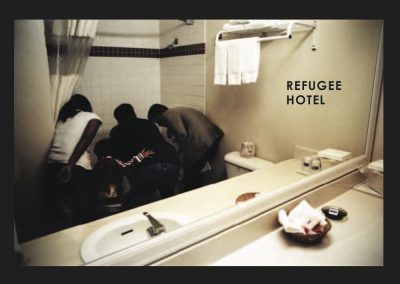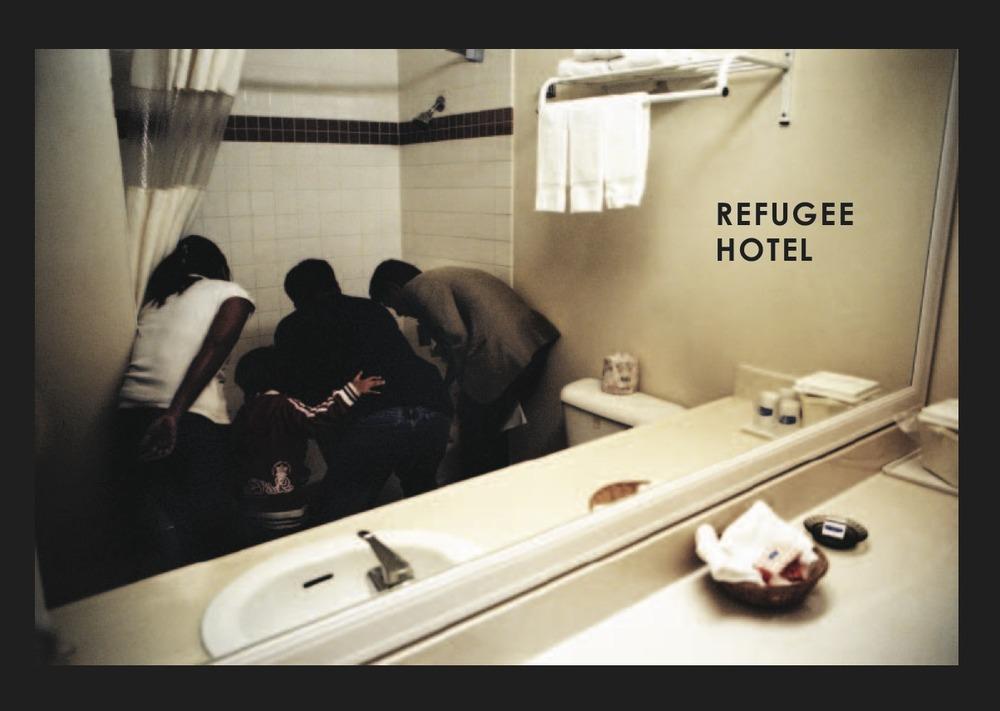 On the cover of Refugee Hotel, a Burmese family lodged in a California hotel peers over the edge of a bathtub, gazing at it as though they’d never seen one before.
On the cover of Refugee Hotel, a Burmese family lodged in a California hotel peers over the edge of a bathtub, gazing at it as though they’d never seen one before.
It’s one of many fascinating images from this collaboration between photographer Gabriele Stabile and writer Juliet Linderman. Through striking photographs and moving personal accounts, Refugee Hotel offers a firsthand look at the first days of refugees in the United States. We follow along in their journey from confusion-filled first nights in airport hotels to the development of new lives.
The pair does an exemplary job of weaving together visual media and prosaic storytelling to create a unique insight into refugee resettlement, drawing in the reader from the first pages.
In one particularly striking image, a Somali mother gathers her children, all covered beautifully in Somali fabric but with additional layers for bitter, Midwest winter weather. They stand in the hotel hallway, unsure of which room is theirs, with looks of confusion on the mother’s face while the children huddle sleepily around her.
Many of the photos in the book are quite ordinary, representing daily life for a typical American—the only difference being that these are the faces of those a world away from their homes. Sabile employs pedestrian yet surreal snapshots of children, weddings, and nature to represent the uncertainty of new life in America. In many, refugees seated by windows simply gaze out on the world with expressionless faces.
Other images capture refugees acting out familiar scenes of prayer and worship in new places. There are images of women adorned in bright African fabrics clapping and singing, a congregation of people praying, a Hindu man sitting cross-legged by himself in an empty hall, and a solitary Muslim woman praying next to her bed.
Amid Sabile’s photographs, Linderman includes an insert of beautifully written refugee memoirs, bringing the reader into the intimate lives of their authors. We learn not only of the dire circumstances in their home countries, but also of their complicated feelings toward their new country. In one instance, an Iraqi man rails bitterly against the American war machine that uprooted him and brought him to the United States.
Linderman shares the stories of refugees from Bhutan, Burma, Burundi, Ethiopia, Iraq, and Somalia, illustrating the variety of calamities that drive people from their home countries. Many become refugees as result of armed conflicts and in turn become reliant on international refugee relief. Others are targeted for having the “wrong” political affiliation, ethnicity, or sex.
Linderman also sheds some light on the American cities hosting the freshly arrived refugees: Amarillo, Minneapolis, Charlottesville, Mobile, and Erie. Resettlement in Minneapolis and Mobile happens with relative ease due to the low cost of living and thriving economies in each. Another factor is the significant refugee population presence—in Minneapolis alone, over 30,000. For the remaining cities this is not the case, with high unemployment rates and intimidating costs of living greeting refugees upon their arrival. It’s a compelling yet understated glimpse at the economic hardship that must be overcome to live a decent, free life.
After their initial photography sessions and interviews, Stabile and Linderman traveled to the refugees’ new homes months later to conduct exit interviews on how they have taken to the American lifestyle. All but one individual interviewed for the book had adapted well and showed no regret in coming to the United States to settle. Even those who endure economic hardship recall no regret whatsoever—they found life in America far better than what they left behind.
Along the way, Linderman and Sabile give us captivating insight into the despair that confronts many refugees upon their landing, without re-victimizing their characters.
